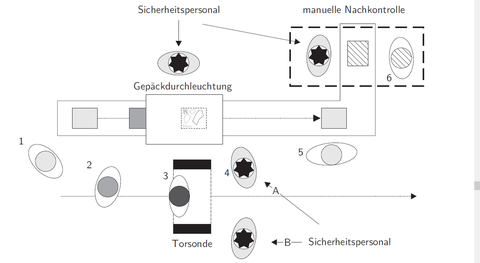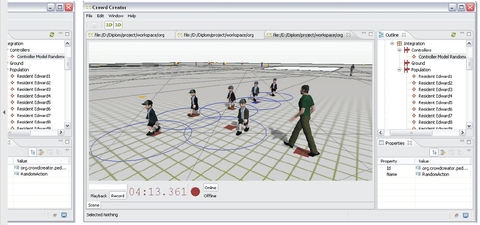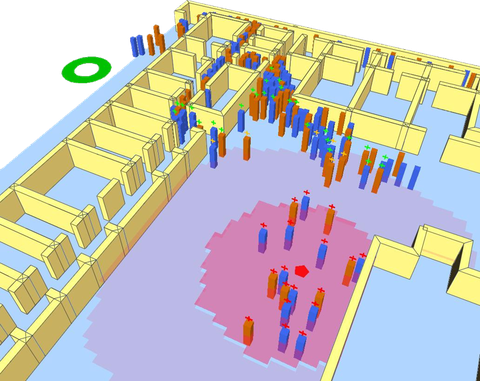Terminal Operations
The research area ,,Terminal operations" focuses on all operational processes and facilities of airport terminals. This includes, for example, the development of models in order to describe and predict the movement of individuals in airport terminals. These models are particularly relevant to the Chair as they allow to optimise the guiding signage through complex building layouts as well as to describe specific behaviours in emergency situations. Based on a detailed analysis of all the passenger handling processes, a virtual simulation environment has been developed and is constantly being validated by comparing real-life and simulated data. The development of emergency planning concepts and the analysis of different signage designs, as for Dresden Airport car park, directly benefit from the results.
Passenger Modelling and PaxTrac
When modelling human behaviour, individual interdependencies create group dynamics that influence the individual course of motions temporally and spatially. Therefore, the whole system is ideally described by modelling the smallest component: Microscopic Modelling allows describing each individual's pattern of motion separately and differentially. The motion-sequence is modelled using a stochastic approach that is built on the principles of the cellular automaton. This helps to depict the varying decision-making by defining probabilities of presence.It is required to exploit and feed the model with real-life data in order to calibrate it. This need has led to the development of a system which is able to record the positions and trajectories of people in the terminal by pictures and video footage automatically at any time. For this purpose, Dresden Airport offers perfect conditions: The constructional properties of the terminal allow positioning the recording devices in such a way that a wide and unobstructed view into the terminal is guaranteed. Because of the huge distance between the cameras and the observed areas, it can be assumed that the motion-sequence of the passengers is not influenced by the data recording. Software that was developed in cooperation with the Chair of Air Transport Technology and Logistics allows converting the pictures into individual motion-trajectories of the passengers considering the relevant legal requirements. Particular interest lies on gender-specific differences and the dependency of the movement on group size, number of baggage and travel motivation.
Process analysis
To be able to describe the passenger's behaviour in the terminal, required process parameters are defined and validated by measurements at different airports. From the passenger handling process-modelling point of view, the process-related handling parameters additionally have to be determined. Therefore, the relevant process stages are analysed in detail and, if necessary, divided into different sub-processes. At Stuttgart Airport, extensive data records were realised to describe all the relevant handling-processes during the departure. Having statistically analysed the specific process-times of the various handling-stages, valid distribution assumptions for modelling the passenger handling process are available. Alongside modelling the process flows it is also of particular research interest how the experience of the deployed personnel, individual passenger parameters such as group size or baggage or system disturbances potentially influence the process.
Virtual environment
The development of software for passenger-modelling takes place in three steps. Starting with first test implementations of the algorithms, statistical evaluation and elementary graphic representation of the results are carried out simultaneously. By focusing on the efficiency of the chosen algorithms in the first step, there is no division of the used software-structures. With increasing complexity of the software, however, there has to be created an adequate setting enabling a division between the development of the particular motion model and the graphic representation. In the first prototype, persons are represented as spatially oriented cuboids that can facilitate information about their condition via additional graphic features. In the course of the S3 - Security from Seat to Seat research-project, the visualisation could already be used to realistically picture the process of evacuation. With evolving implementation, the technical implementation of the prototype had to be designed more efficiently. Since already existing simulating systems do not have the required flexibility and since the development effort rises with increasing complexity when using object-oriented programming-language, a stardardised software-frame (eclipse-environment) is necessary. Besides the earlier described animation possibilities, the developed prototype offers a graphic user interface and a programming interface. Consequently, there are two independent areas: the behaviour model and the visual representation.
Signage
In buildings, such as airports, where a huge number of persons must reach their different respective destinations often under time pressure, a highly sophisticated and consistent guidance system consisting in signs with writing or symbols is essential. In the first place, an orientation system is a filter for standard questions that helps to coordinate movements of crowds. To achieve this filter function it is necessary to consequently employ identical terms and icons. Icons should be commonly valid and internationally standardised in order to be comprehensive for anyone and to avoid stimulus satiation. Therefore, it is recommended to revert to usual icons instead of constantly designing new ones when implementing new orientation systems. Inaccuratenesses within the orientation system lead to longer walks for non-locals and quickly can provoke unwanted side-effects for a huge crowd. In the course of a current action, Dresden Airport's car park is extended. A project work contemplates the creation of a consistent, logic and comprehensible guidance and signage within the car park. Thereby, an efficient guidance and signage as well as the consistent corporate design must satisfy economic, legal, operational and anthropotechnical requirements. Signage should be fitted to places, where it can be distinguished from its environment and from advertisements or similar. In addition it must be easily legible; In difficult lighting illumination is recommended. Legibility of the information is the first priority. To not overwhelm the searching with unnecessary information it is recommended to minimise the number of signs and to only place essential signs.
emergency planning
Airports as multi-functional systems and nodes for air traffic are facing constantly rising requirements. With the trend shifting towards modern, architecturally-valuable Terminals with vast non-aviation areas offering their visitors themed environments and a huge variety of service features, exceptionally high standards with regard to security concepts must be met. This is more important than ever, as the growing number of passengers and their demanding requirement profiles comprise a complex overall system together with the expanding amount of other airport-stakeholders. While airside-handling follows strict guidelines, there are no standardised rules for emergency concepts of entire terminals. Due to the variety of functions of terminals, a broad range of legal regimes would have to be considered - even if they do not apply immediately to terminal buildings. This circumstance leads to every airport creating its own emergency concept that considers the common requirements as well as the individual on-site conditions. Composing an emergency plan, i. e. creating an overall emergency plan including all the supplementary plans and documents, installation of offices in charge, assuring their interaction and provisioning of the needed equipment result from the legal specifications and from the high potential of latent danger that exist in such a complex system as an airport is. Emergency planning consists of preventive and active measures. Preventive emergency planning shall ensure that all the necessary measures in order to guarantee safe operation are taken and thereby provide for the maximum - in the range of possibilities - security. In case of an emergency the main goal of active emergency planning is to react in the right way as quickly as possible to protect lives. This includes the expeditious and organised evacuation of every person that possibly could be harmed and a quickly controlled handling of the emergency. In order to achieve this goal and guarantee a smooth process without delay, a clear structuring of responsibilities and an organised and a clearly laid-out documentation of the relevant emergency procedures is elementary.
Publications
Schultz, M., L. Rößger, H. Fricke and B. Schlag (2012)
Group dynamic behavior and psychometric profiles as substantial driver for pedestrian dynamics, International Conference on Pedestrian and Evacuation Dynamics (PED), Zürich
Schultz, M. (2012)
Stochastic transition model for pedestrian dynamics, International Conference on Pedestrian and Evacuation Dynamics (PED), Zürich
M. Schultz and H. Fricke (2011)
Managing Passenger Handling at Airport Terminal, USA/Europe Air Traffic Management Research and Development Seminar (ATM Seminar), Berlin
M. Schultz and H. Fricke (2010)
Stochastic Transition Model for Discrete Agent Movements, Conference on Cellular Automata for Research and Industry (ACRI), Dresden
Schultz, M., T. Kretz and H. Fricke (2010)
Solving the Direction Field for Discrete Agent Motion, Conference on Cellular Automata for Research and Industry (ACRI), Dresden
Schultz, M., B. Oreschko and C. Schulz (2008)
Tracking Passengers at Airports for User Driven Terminal Design, Innovative Research Workshop (INO Workshop), Paris
Schultz, M., C. Schulz and H. Fricke (2007)
Enhanced Information Flow and Guidance in Airport Terminals using best Passenger's Visual Perception, Innovative Research Workshop (INO Workshop), Paris
Schultz, M., A. Wachtel and H. Fricke (2007)
Standardized concept for passenger guidance systems at aerodromes, Council of European Aerospace Societies (CEAS), Berlin
Schultz, M., A. Wachtel and H. Fricke (2007)
Multi-purpose passenger guidance systems for terminals, Aachen Aviation Convention (AAC), Aachen
Schultz, M., S. Lehmann and H. Fricke (2006)
Pedestrian dynamics in airport terminals considering emergency cases, Congress of the International Council of the Aeronautical Sciences (ICAS), Hamburg
Lehmann, S., M. Schultz and H. Fricke (2005)
Sicherheitsstrategien in Flughafenterminals, Verkehrswissenschaftliche Tage (VWT), Dresden
Schultz, M., S. Lehmann and H. Fricke (2005)
A discrete microscopic model for pedestrian dynamics to manage emergency situations in airport terminals, International Conference on Pedestrian and Evacuation Dynamics (PED), Dresden
Schultz, M., S. Lehmann and H. Fricke (2004)
Development of a computer-aided model for reliable terminal evacuation simulation - a statistical approach to handle unpredictable passenger behaviour , International Conference on Research in Air Transportation (ICRAT), Zilina, Slovakia
Lehmann, S., M. Schultz and H. Fricke (2004)
Bewertung von Sicherheit und Notfallmanagement an Verkehrsflughäfen, Deutsche Gesellschaft für Luft- und Raumfahrt (DGLR), Dresden
Schultz, M., S. Lehmann and H. Fricke (2004)
Modellbildung und Parametrisierung eines zellulären Automaten zur Simulation von Notfall-und Evakuierungsszenarien in einem Flughafenterminal, Deutsche Gesellschaft für Luft- und Raumfahrt (DGLR), Dresden



